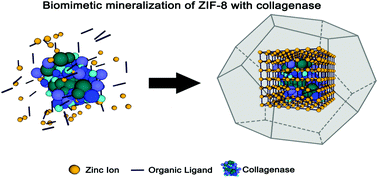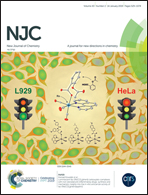Encapsulation of collagenase within biomimetically mineralized metal–organic frameworks: designing biocomposites to prevent collagen degradation†
Abstract
A growing class of multifunctional porous materials termed metal–organic frameworks (MOFs) has attracted attention for immobilization of biomolecules via self-assembly of inorganic and organic building blocks. Herein, we report the rapid formation of MOF shells surrounding collagen-degrading enzymes by using a biomimetic mineralization approach. Bacterial collagenase, which is functionally related to endogenous proteases in the human body, was used as a nucleating agent to induce the mineralization of zeolitic imidazolate framework-8 (ZIF-8) as a crystalline shell. This zinc-based MOF material was selected due to its remarkable stability under physiological conditions and good biocompatibility. The straightforward, water-based synthesis yielded microporous collagenase-embedded ZIF-8 particles. Once immobilized inside the biomimetically mineralized MOF, the protease presented limited catalytic activity, being ineffective in the proteolysis of a collagen-like peptide. In conclusion, biomimetic mineralization of ZIF-8 using collagenase not only provided immobilization of the enzyme, but also enabled the control of its activity. This synthetic approach provides a potentially useful concept in the prevention of proteolytic activity involved in the degradation of collagen matrices in living organisms.



 Please wait while we load your content...
Please wait while we load your content...